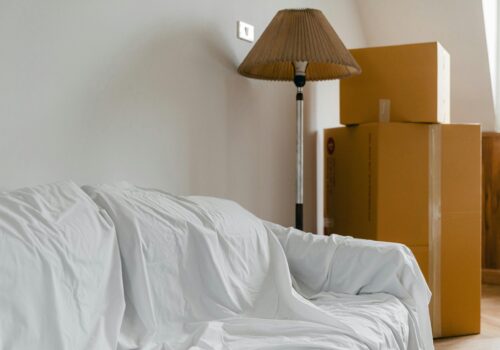Decluttering is a powerful practice. It impacts your well-being by organizing your home and providing you with peace of mind. Moving to a new home presents a unique opportunity to declutter and lighten your load. Let’s discuss the benefits of decluttering before the move and why it’s the best time to do so. In this guide, we’ll discuss:
- Why decluttering is important;
- What are the myths about the decluttering process and home organization;
- Ways to prepare and find the motivation how to declutter before a big move or small relocation;
- Go through the steps of the decluttering process;
- Give you practical advice on how to sort things;
- what to pack first for the move and what to leave till the last minute;
- What do you do with things you hesitate to dispose of?
Why Decluttering Is Important
Having a cluttered space can negatively affect your mental health and well-being. Making your place more organized goes beyond just getting it tidier. Studies have proven that clutter often influences stress and anxiety levels. The journal Personality and Social Psychology Bulletin published a study that found people who described their homes as cluttered tend to have elevated levels of the stress hormone cortisol. This is a body response that can result in irritability, poor sleep quality, and fatigue.
Common Mistakes about Decluttering
There are 2 main mistakes about clutter and cleaning don’t align with reality.
One-Time Cleanup Mistake
The first mistake is thinking you can achieve a permanently tidy space with a one-time cleanup. A clutter-free home is an ongoing process because life is dynamic, and our needs change. So, periodic decluttering is perfectly normal.
Perfect Internet Life Mistake
The second common mistake is thinking that you can organize your space just like in those perfect Internet photos. Organized shelves and spaces found online require effort to maintain. They look great but need investment to stay that way. These images are carefully staged and prepared, playing to our natural desire for order and symmetry, but they don’t reflect daily life.
Trying to copy them can be unrealistic and counterproductive. For instance, using containers for grains like those in those ideal photos involves more than just transferring them from their original packaging to your pantry. You’ll need to organize suitable containers, which can add extra time to your grocery shopping routine. Furthermore, you’ll have to wash the containers and monitor expiration dates and cooking times.
How to Find the Motivation to Declutter
There’s never a “perfect” time to declutter because doing it regularly is just part of life. Instead of seeing decluttering as a chore, imagine it as a game where you cannot lose. The reward? It is a neater, more organized space and a refreshing vibe. Winning isn’t everything here; it’s more about playing the game and enjoying whatever benefits come. However, some life occasions might give you additional motivation. For instance, moving to a new home or changing seasons is a perfect opportunity to eliminate unnecessary things.
How to Find Motivation to Declutter Before the Move
It’s about more than better management of the move. We listed some of the benefits for motivation to declutter before the move.
- Optimize Your New Space. One primary reason to declutter before moving is to make your new space more comfortable. Only the items you truly need and like will make their way to your new home, resulting in a more organized, efficient, and spacious living environment.
- Reduce Moving Costs. Moving costs can add up quickly, especially if you have a significant amount of belongings. The more items you move, the more you’ll pay for packing materials, transportation, or storage. Decluttering during the move allows you to reduce the number of items you need to deliver to a new place, saving you money.
Keep a list of how much money you’ve made from selling and donating items before the move. It’s a great motivator to keep going. For example, the goal might be to spend this money on the celebration with your friends and relatives when you move into your new home.
- Simplify Unpacking. Unpacking is sometimes an even harder task because you have to understand how to organize a new home after moving and create a system of storing at a new place. Decluttering before the move can make it significantly more manageable. When you arrive at your new home, you won’t be overwhelmed by numerous boxes filled with items you don’t need or don’t know where to put them. Instead, you’ll have a limited collection of belongings that can be easily unpacked and organized in your new home.
- Give A Fresh Start. Moving can be a chance to start anew, and decluttering facilitates this process. Some items might be holding you back from your old home or associated with negative memories. Relocating to a new place is the time to leave behind those unnecessary things and get a more positive outlook on your new living situation.
- Sustainable Living. You can reduce waste and live sustainably by responsibly disposing of unnecessary items. Consider donating furniture or recycling items to minimize your impact on nature. What you don’t use might help other people in their everyday lives, and you’ll make their life cycle much longer.
Decluttering during a move is not just about tidying up—it’s a strategic decision that positively impacts your new living space, reduces moving costs, simplifies unpacking, and provides a fresh start. It’s an opportunity to let go of the past, embrace the present, and choose the way for a more organized future in your new home.
You don’t have to do it alone whenever you want to declutter. Our professionals and many services are available to assist you. Whether it’s heavy furniture lifting, packing belongings for storage, providing seasonal storage solutions, or helping with junk removal or delivery to the donation center, extra hands are ready to support your efforts. Call us or use a form for a quote to get a free estimate for junk removal, delivery to Boston donation centers, or labor-only moving help for home reorganization or furniture rearranging.
Step 1. Preparing for Decluttering and Making It Enjoyable
Decluttering is a way of keeping things organized, and it’s important to prepare and start it effectively. Marie Kondo, an expert in decluttering and organization, advises preparing well and making mindful choices. It’s not about throwing away things randomly but about creating a space that sparks joy.
You’ll be on your way to a more organized and peaceful living space by making the process enjoyable. Decluttering is a continuous process, so take it one step at a time. Treat it not as a dull task but as a game you cannot lose, and the reward will be a better-organized space than before.
Here are 7 easy steps on how to prepare for decluttering
- You will Need More Time than You Plan
When you plan to declutter, remember that it may take longer than you think. Give yourself extra time, and don’t be too hard on yourself; start tidying up your space at your own pace.
- Make It Enjoyable
Create a comfortable atmosphere. Choose your favorite music or listen to an engaging podcast. Music can add rhythm to your task and prevent overthinking each item, which helps you make quicker decisions. Ensure the area is well-lit to improve visibility and set a positive mood.
- Evaluate Your Current Storage Methods
Assess your current storage methods and identify areas that require improvement. Consider each area of your home separately, such as your wardrobe, kitchen, and living room. Ask yourself questions like, “Are items organized logically and conveniently?” and “Do you have special spaces for different categories of belongings?”
- Identify Necessary Organizers for Long-Term Storage
Determine what type of storage organizers and materials you’ll need. For items you won’t use often or for a while, choose boxes or bags instead of costly organizers. Collect the necessary supplies, trash bags, labeling materials, and common storage organizers such as boxes, vacuum bags, and containers for long-term storage.
- Select Your Starting Point:
Choose a smaller, more manageable area or category of items to declutter first. Start with the obvious clutter, such as a stack of old magazines, a cluttered closet, or a kitchen pantry. A narrow focus will set you to achievable goals and help you to avoid unnecessary stress and hesitation.
- Set Clear Goals and Celebrate Small Wins
Define what you aim to achieve. Having clear goals will keep you motivated. For example, if you declutter before moving, “I want to create a more spacious and organized living room after moving into my new home.” “I aim to reduce the clutter in my wardrobe and make it easier to organize clothes in my new place .” Clear objectives will help your decluttering efforts and keep you motivated.
- Declutter Solo:
It’s often best to tackle decluttering independently rather than with a partner or family member. This allows for faster decision-making, eliminates potential disagreements, and helps you maintain motivation. And here is why:
- Streamline your decision-making: When decluttering on your own, you can make decisions quickly without discussing or debating. This prevents overthinking and saves time.
- Avoid disagreements: Decluttering with others can sometimes lead to disagreements over what to keep and discard. Going solo eliminates this potential source of tension.
- Stay motivated: Achieving progress on your own can be incredibly motivating. Observing the outcomes of your hard work will motivate you to remain dedicated to the process.
Remember to be respectful to others when decluttering shared belongings. These tips will help you declutter efficiently before moving, making the process smoother and less stressful.
Step 2. Decluttering: How to Choose and Let Go Unnecessary items
After preparing for decluttering, it’s time to move on to step 2: efficiently eliminating unnecessary items for smoother home organization. This step creates more space and encourages a more thoughtful approach to what you keep in your home, which is essential for home improvement, efficient space organization, and hassle-free moving.
-
Choose One Area or One Type of Items
If you’re ready to tackle the clutter in your closet or medicine cabinet, there’s an essential step you can’t afford to skip: gathering items by type.
Before you start tidying up:
- Take everything out of the space and stack it together.
- For clothes, lay them on the floor or bed, and for dishes, put them on the table.
- Keep the area you’re working in empty.
Why is this important? You need to clear out the old storage system to create a new one. Only then can you arrange everything differently to suit your needs better. If you sort items in parts, you may find yourself disrupting your organization when you come across more of the same items in another area. For example, if you’re decluttering your wardrobe, take out all your clothes, including items usually stored in different parts of your home.
But most importantly, seeing all your items together makes it easier to decide what to keep and discard. Having all items of a particular category in one place provides a clear view of what you have. This often encourages individuals to be more willing to let go of duplicates or items they no longer need. For instance, if you gather all your kitchen gadgets together, you might realize you have multiple similar tools. Letting go of two out of ten t-shirts is easier than one out of two.
When items are grouped, individuals tend to take a more objective look at their possessions, which can be particularly helpful when deciding to part with sentimental items. If you gather all your sentimental items in one place, it may be easier to choose a few with deep meaning and let go of the rest.
Don’t worry if you can’t discard everything unnecessary at once. This is a normal feeling. Later, you’ll become more critical of things, and it’ll be easier to let go.
And one final tip: try piling up similar items when folding clothes. You may be surprised at how many there are, which can help you decide what to keep.
Are you ready to take the next step and get organized? Remember to gather items by type for a more efficient and effective decluttering process.
2. Divide Items in Four Categories
Organizing your belongings can be easy if you follow these four simple categories: “use regularly,” “use infrequently or seasonally,” “probably to dispose of, don’t use” and “dispose.” The goal is to keep and move to new place the things you need and use, and get rid of the items that no longer serve a purpose in your life. Here’s how to categorize your belongings effectively.
When determining an item’s category, consider when you last used it and how often you usually use it. If you used a hammer yesterday, it likely is not an item you use regularly. It’s more likely that it’s an item you rarely need.
When sorting through items, spend 10-15 seconds on each. Try only to examine it briefly so as not to recall its history. If you feel that you’re spending too much time on an item, set it aside and return to it later. This will save you time in the long run.
Begin categorizing items by randomly picking them and sorting them into four categories. You might place your favorite sweatshirt into the “regularly use” category, a sweater into the “seasonal” category, old jeans into the “probably to dispose of” category, and a t-shirt with paint stains into the “for disposal” category.
Use Regularly: These are things you use frequently in your daily life, such as everyday clothing, cookware, toiletries, and work-related tools. Ask yourself if you use them at least once a week, if they are essential for your daily routines, and if they contribute to your daily comfort or productivity. This category is the most important for organizing your home.
Since these items are essential for your daily routines, it’s best to pack them closer to the move date. Aim to leave them for packing within the last week before your move to ensure you have access to them until the last minute.
Use Infrequently or Seasonally: These items are used occasionally or during specific seasons, like holiday decorations, seasonal clothing, and sports equipment. Ask yourself if you use them less than once a month, if they are related to a specific activity or season, and if you can easily replace them.
These could also be sentimental items that hold significant value or emotional attachments, like heirlooms, keepsakes, or gifts from loved ones. Ask yourself if they represent cherished memories or relationships and if they can be displayed or stored in a way that doesn’t clutter your daily space. If not, consider placing them in the next category, Probably to Dispose of.
These items can be packed earlier in the moving process, preferably a few weeks before your move. Packing them early allows you to organize your space effectively while ensuring you have access to them as needed before the move. You can pack these items in vacuum bags or clear plastic bins with lids and label the bins with their contents for easy identification.
Probably to Dispose (Something Don’t Use, but Can’t Let Go): This category is for usable items but that you have not used for a long time for one reason or another. Ask yourself if you have used them in the past year if they serve a purpose, and if they are in good condition and valuable to someone else. Here, you can find unsuccessful gifts, books you will never read again, furniture that won’t fit in your new space, and clothes and toys in good condition that you or your children no longer use. You can either give away, donate, sell, or throw away these items, so label the boxes and bags clearly for their content.
Start sorting these items as soon as possible, ideally a month or more before your move. This gives you ample time to decide whether to keep, donate, sell, or dispose of them. Once you’ve made your decisions, pack them accordingly.
Disposal: Anything broken, expired, or no longer usable can be disposed of or recycled. Examples include broken appliances, outdated electronics, expired cosmetics and medicine, worn-out clothes, and items with bad memories.
Dispose of these items as soon as possible, ideally before you start packing for your move. This ensures you’re not transporting unnecessary items to your new home. To make the disposal process efficient, consider ordering junk disposal and furniture removal services offered by Flash Moving.
Remember, the key to successful decluttering is being honest with yourself about the usefulness and value of each item. By categorizing your belongings into these four groups, you can streamline the decluttering process and make more informed decisions about what to keep, what to let go, and how to organize the storage.
When sorting through your belongings, you may come across items that are hard to decide what to do with. For instance, you may have clothes that are too small or not in great condition. It’s okay to place those items in a pile labeled “Probably to Dispose” together with items you’re unsure about. Later on, go through that pile again and divide it into two. You might decide to give or sell some of those items, while others may be better off being thrown away.
There may be items you don’t use regularly, such as books or photos with special memories. Sometimes, it’s hard to let go of those things. If unsure, it’s best to put them in a pile labeled “infrequently or seasonally” and sort through them again later.
You’ll determine what works best for you as you go through the sorting process. Some people prefer to start by setting aside the items they use more often, while others prefer to gather what they plan to dispose of first. You can try both methods or come up with your own
3. How to Handle Items You Hesitate to Discard Before a Move
Suppose you’re facing the task of decluttering before a move, and you’ve sorted your items into four categories, but there are still some you’re hesitant to discard. Perhaps it’s belongings like old curtains or pillows you no longer like, but which are still usable or items from your partner they’re not ready to let go of. Revisit these items with a fresh perspective. Remember, items from the “Probably to Dispose” category can be moved to the “Disposal” pile, but not the other way around.
Once you’ve done this, you’ll have two categories left. Dealing with items in the “disposal” pile is straightforward — they can be thrown away or recycled. But with items in the “Probably to Dispose” category, there are a few extra considerations to keep in mind, especially if you’re preparing for a move:
Store Them: Consider purchasing storage containers to store these items before and after your move. It’s important to label the containers so that they can be easily identified later on.
Storage containers can be found at local stores like Home Depot or Walmart. They come in various sizes and typically range from $10 to $20. Opt for containers with secure lids to protect against dust and moisture. Transparent containers are useful for easily spotting items, but if some of your belongings are sensitive to light (like colored clothes), consider opaque containers.
You can keep these containers in a spare room, garage, or rented storage unit until you’re settled in your new home.
Renting a storage unit can provide a convenient solution for storing items during the local relocation or before a long-distance move. Flash Moving & Storage also provides storage units for rent, and we can even pack and pick up your items from home. Our storage units for rent in Boston are closed vaults with size 10×5. They are located in warm, dry, and secure storage facilities. Items stored there will keep your home neat, and storage units are suitable for large items like garden furniture, snowboards, bikes, etc.
Storage has an unexpected benefit. When you encounter the container or pay the rent for the storage unit, you might realize you want to stop storing these items. Thanks to this, you might help part with them more easily.
Sell Them: If you want to downsize before your move, consider selling these items online or through a garage sale. This will reduce the number of items you need to move and help you earn some extra cash.
Online platforms like Craigslist, Facebook Marketplace, or eBay are great for selling items locally. How to sell unnecessary items before the move? Take clear and well-lit photos and provide accurate descriptions to attract potential buyers. Lower prices lead to quicker sales. Children’s items, toys, and new clothing are particularly popular.
There are also groups for collectors who may be interested in rare items like old coins or antiques. Search for them using the term “collecting” and add the item’s name.
Donate Them: Another option if you’re looking to declutter before your move is to donate furniture and items to charity. Not only does it help those in need, but it also saves you the hassle of moving unwanted items.
Every city has foundations that accept items for those in need: clothing, furniture, and bedding. Research local charities or donation centers in your area that accept household goods, clothing, and furniture. Look for them online using the search term “donate items to charity in Boston.” Information about such organizations can also be found in social media groups and local media. Remember that items for donation should be clean, intact, and in good condition. Many organizations offer pickup services for donation of large items, making it convenient for you to donate before your move. Flash Moving Company also provides moving services in Boston like delivery to donation centers or junk removal and furniture disposal.
Addressing these items before your move will lighten your load and make the moving and unpacking process easier. Plus, you’ll start fresh in your new home without unnecessary clutter, and you’ll need less time for efficient home organization and storage solutions.






